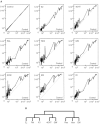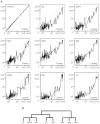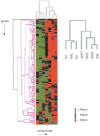Molecular classification of selective oestrogen receptor modulators on the basis of gene expression profiles of breast cancer cells expressing oestrogen receptor alpha
- PMID: 12177783
- PMCID: PMC2376139
- DOI: 10.1038/sj.bjc.6600477
Molecular classification of selective oestrogen receptor modulators on the basis of gene expression profiles of breast cancer cells expressing oestrogen receptor alpha
Abstract
The purpose of this study was to classify selective oestrogen receptor modulators based on gene expression profiles produced in breast cancer cells expressing either wtERalpha or mutant(351)ERalpha. In total, 54 microarray experiments were carried out by using a commercially available Atlas cDNA Expression Arrays (Clontech), containing 588 cancer-related genes. Nine sets of data were generated for each cell line following 24 h of treatment: expression data were obtained for cells treated with vehicle EtOH (Control); with 10(-9) or 10(-8) M oestradiol; with 10(-6) M 4-hydroxytamoxifen; with 10(-6) M raloxifene; with 10(-6) M idoxifene, with 10(-6) M EM 652, with 10(-6) M GW 7604; with 5 x 10(-5) M resveratrol and with 10(-6) M ICI 182,780. We developed a new algorithm 'Expression Signatures' to classify compounds on the basis of differential gene expression profiles. We created dendrograms for each cell line, in which branches represent relationships between compounds. Additionally, clustering analysis was performed using different subsets of genes to assess the robustness of the analysis. In general, only small differences between gene expression profiles treated with compounds were observed with correlation coefficients ranged from 0.83 to 0.98. This observation may be explained by the use of the same cell context for treatments with compounds that essentially belong to the same class of drugs with oestrogen receptors related mechanisms. The most surprising observation was that ICI 182,780 clustered together with oestrodiol and raloxifene for cells expressing wtERalpha and clustered together with EM 652 for cells expressing mutant(351)ERalpha. These data provide a rationale for a more precise and elaborate study in which custom made oligonucleotide arrays can be used with comprehensive sets of genes known to have consensus and putative oestrogen response elements in their promoter regions.
Figures



Similar articles
-
Gene expression profiles with activation of the estrogen receptor alpha-selective estrogen receptor modulator complex in breast cancer cells expressing wild-type estrogen receptor.Cancer Res. 2002 Aug 1;62(15):4419-26. Cancer Res. 2002. PMID: 12154049
-
Xenoestrogens and the induction of proliferative effects in breast cancer cells via direct activation of oestrogen receptor alpha.Food Addit Contam. 2004 Feb;21(2):134-44. doi: 10.1080/02652030310001641177. Food Addit Contam. 2004. PMID: 14754635
-
Oestrogenic activity of isobutylparaben in vitro and in vivo.J Appl Toxicol. 2002 Jul-Aug;22(4):219-26. doi: 10.1002/jat.860. J Appl Toxicol. 2002. PMID: 12210538
-
Regulation of oestrogen receptor gene expression: new insights and novel mechanisms.J Neuroendocrinol. 2009 Mar;21(4):238-42. doi: 10.1111/j.1365-2826.2009.01830.x. J Neuroendocrinol. 2009. PMID: 19207817 Review.
-
Gene expression profiles of the oestrogen receptor in breast cancer.Neth J Med. 2010 Oct;68(10):291-302. Neth J Med. 2010. PMID: 21071774 Review.
Cited by
-
Structural insights into Resveratrol's antagonist and partial agonist actions on estrogen receptor alpha.BMC Struct Biol. 2013 Oct 25;13:27. doi: 10.1186/1472-6807-13-27. BMC Struct Biol. 2013. PMID: 24160181 Free PMC article.
-
Retrospective Analysis of the Effect of Postmenopausal Women Medications on SARS-CoV-2 Infection Progression.Life (Basel). 2024 Sep 3;14(9):1107. doi: 10.3390/life14091107. Life (Basel). 2024. PMID: 39337891 Free PMC article.
-
Progesterone: the ultimate endometrial tumor suppressor.Trends Endocrinol Metab. 2011 Apr;22(4):145-52. doi: 10.1016/j.tem.2011.01.005. Epub 2011 Feb 25. Trends Endocrinol Metab. 2011. PMID: 21353793 Free PMC article. Review.
-
Synthesis and Anti-Melanoma Activity of Acryloyl Pyridinone Analogues.Chem Biodivers. 2023 Dec;20(12):e202301550. doi: 10.1002/cbdv.202301550. Epub 2023 Nov 30. Chem Biodivers. 2023. PMID: 37994208 Free PMC article.
-
Resveratrol as Chemosensitizer Agent: State of Art and Future Perspectives.Int J Mol Sci. 2021 Feb 19;22(4):2049. doi: 10.3390/ijms22042049. Int J Mol Sci. 2021. PMID: 33669559 Free PMC article. Review.
References
-
- BagdadeJDWolterJSubbaiahPVRyanW1990Effects of tamoxifen treatment on plasma lipids and lipoprotein lipid composition J Clin Endocrinol Metab 7011321135 - PubMed
-
- Barrett-ConnorECoxDAAndersonPW1999The potential of SERMs for reducing the risk of coronary heart disease Trends Endocrinol Metab 10320325 - PubMed
-
- Ben-DorABruhnLFriedmanNNachmanISchummerMYakhiniZ2000Tissue classification with gene expression profiles J Comput Biol 7559583 - PubMed
-
- BentremDJDardesRCLiuHMacGregor-SchaferJZapfJWJordanVC2001Molecular mechanism of action at estrogen receptor alpha of a new clinically relevant antiestrogen (GW7604) related to tamoxifen Endocrinology 142838846 - PubMed
-
- BhatKPPezzutoJM2001Resveratrol exhibits cytostatic and antiestrogenic properties with human endometrial adenocarcinoma (Ishikawa) cells Cancer Res 6161376144 - PubMed
Publication types
MeSH terms
Substances
LinkOut - more resources
Full Text Sources
Medical

